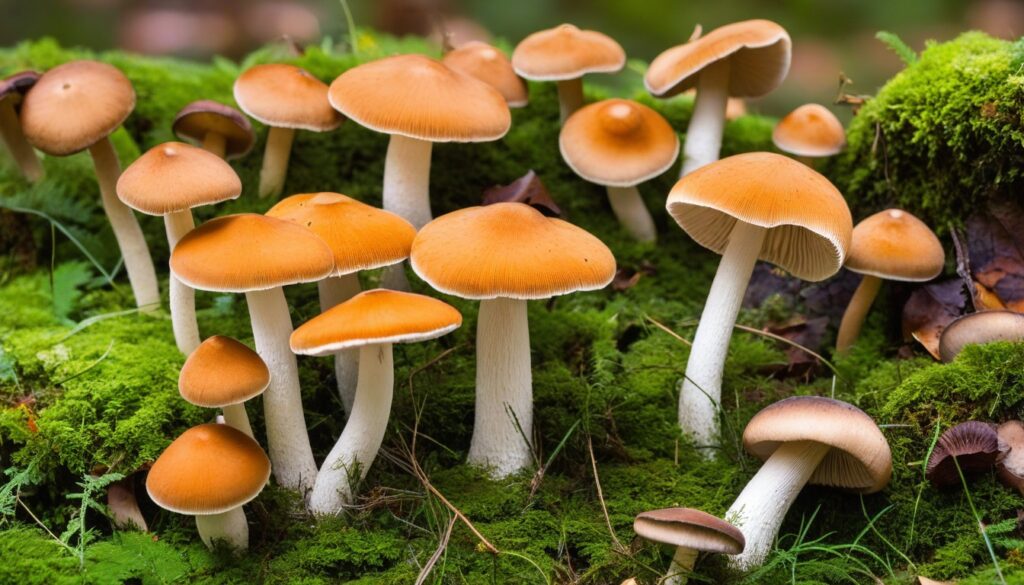Welcome to our foraging guide for edible mushrooms in Utah. If you’re looking for a unique and exciting outdoor activity, mushroom foraging might be the perfect fit for you. Utah is home to a wide variety of delicious gourmet mushrooms, and with the right knowledge and techniques, you can discover some real treasures.
In this guide, we’ll introduce you to the world of mushroom foraging in Utah, from the different mushroom species you may encounter to the best locations for foraging and essential safety tips to keep in mind. We’ll also explore some delicious culinary ideas for cooking with your foraged mushrooms and provide resources to help you continue diving into this exciting hobby.
Key Takeaways:
- Utah is home to a diverse range of edible mushrooms perfect for culinary exploration.
- Foraging for mushrooms in Utah can be a unique and thrilling outdoor activity.
- It’s essential to have proper knowledge about identifying and gathering edible mushrooms to avoid potential hazards.
- Foraging sustainably is essential to preserve mushroom habitats for generations to come.
- Your foraged mushrooms can be preserved and stored long-term for future culinary use.
Edible Mushroom Species in Utah
Utah is home to a diverse range of edible mushroom species, each with unique characteristics and culinary applications. Below is a list of some of the most commonly found edible mushrooms in Utah:
|
Mushroom Species |
Distinguishing Features |
Preferred Habitat |
Culinary Uses |
|---|---|---|---|
|
Matsutake |
Distinctive spicy aroma, brown cap with white patches, and white gills |
Under coniferous trees, especially pine and fir |
A delicacy in Japanese cuisine, used in soups, stews, and rice dishes |
|
Morel |
Honeycomb-shaped cap with a porous surface, cream to tan color |
Found in open woodlands and disturbed soil |
Used in sauces, risottos, and sautéed dishes for their nutty, earthy flavor |
|
Chanterelle |
Trumpet-shaped cap, golden yellow in color, and wavy, instead of gills, underneath the cap |
Often found near conifers but can also be found in deciduous forests |
Used in cream-based soups, sauces, and pasta dishes for their fruity, peppery flavor |
|
Boletus |
Cap and stem are often thicker in the center than at the edges, sponge-like pores instead of gills, and colors ranging from yellow to brown |
Generally found near oaks or conifers in the late summer or early fall |
Used in soups, stews, and pasta dishes for their meaty, nutty flavor |
These are just a few examples of the edible mushroom species that can be found in Utah. As with all foraging, it’s important to properly identify each species and avoid any poisonous look-alikes. And remember, always leave enough mushrooms behind to ensure the health and sustainability of the ecosystem for future foragers!
Best Locations for Mushroom Foraging in Utah
If you’re a mushroom forager in Utah, you’re in luck! There are many spots throughout the state where you can find delicious, edible mushrooms. Here are some top locations to explore:
|
Location |
Mushroom Species |
Best Times to Forage |
|---|---|---|
|
Uinta-Wasatch-Cache National Forest |
Morels, Chanterelles, Porcini, Hedgehogs, Lobster Mushrooms, Oyster Mushrooms, and many more |
May through September |
|
Bear River Migratory Bird Refuge |
Morels |
April through May |
|
Logan Canyon |
Porcini, Chanterelles, Morels |
June through September |
|
Grand Staircase-Escalante National Monument |
Boletes, Chanterelles, Puffballs, and more |
June through October |
When foraging, it’s important to know the appropriate habitats for the mushrooms you’re seeking. Morels, for example, typically grow in disturbed areas near rivers and streams. Porcini, on the other hand, prefer coniferous forests and have a symbiotic relationship with certain trees. Check local weather and wildfire conditions before you head out, and bring plenty of water and snacks. It’s also a good idea to have a field guide or mushroom identification app on hand to help you identify the mushrooms you find.
Happy hunting!
Seasonal Availability of Edible Mushrooms in Utah
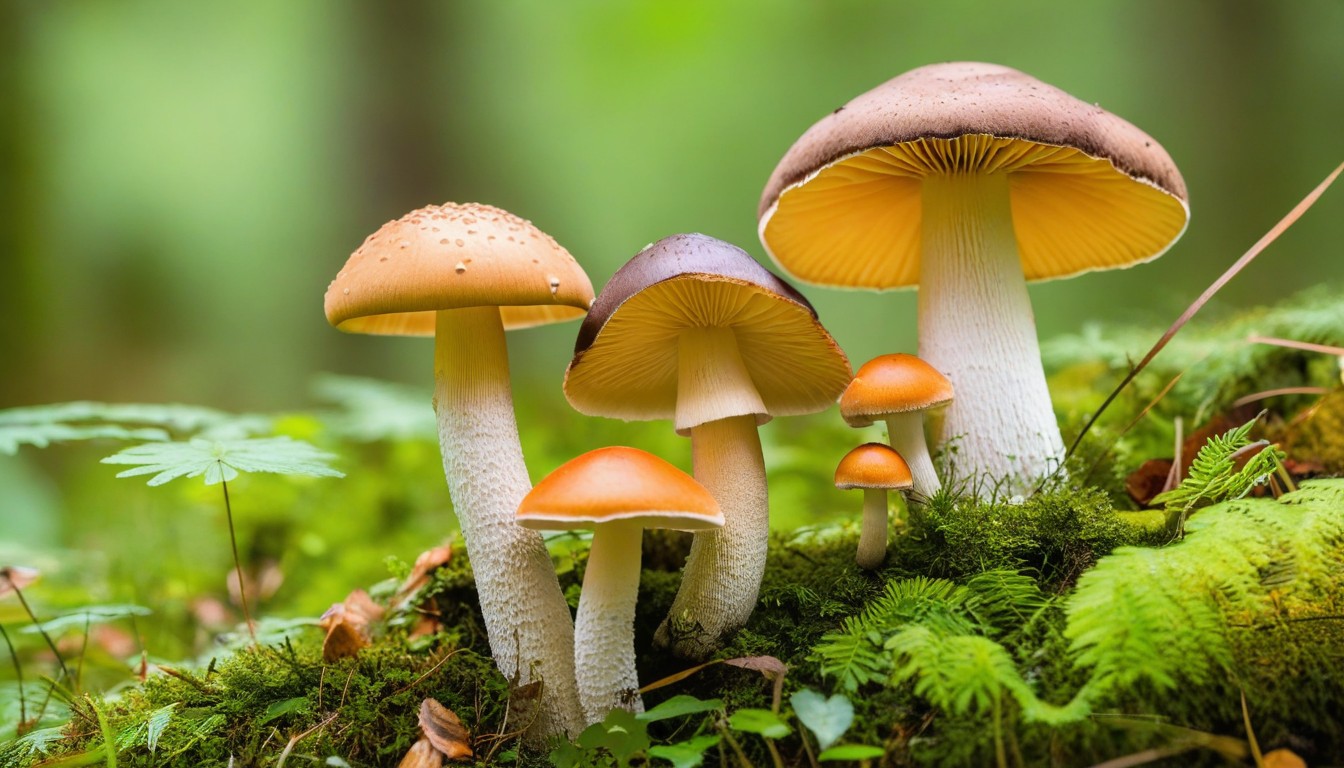
Foraging for wild edible mushrooms is a seasonal pursuit that requires careful planning. In Utah, the mushroom foraging season spans from spring to fall, with specific varieties being most readily available during certain times of the year.
Spring
In the months of March, April, and May, spring mushrooms begin to emerge in Utah. Morels, a highly prized edible mushroom, are one of the first to appear. Other mushrooms that may be found during this time include:
- Ramps
- Fiddleheads
- Lobster mushrooms
Summer
As temperatures rise, so does the abundance of summer mushrooms in Utah. The months of June, July, and August bring an array of mushrooms, including:
- Chanterelles
- Puffballs
- Boletes
Fall
The fall season is often the peak time for mushroom foraging in Utah, with the most diverse selection of mushrooms being available from September to November. This is when mushrooms like:
- Porcini mushrooms
- Hen of the Woods
- Black trumpets
are at their finest.
It’s important to note that the timing of mushroom growth can vary based on environmental factors, such as temperature and rainfall. So it’s always advisable to cross-reference your local weather report and the specific foraging locations for more accurate seasonal data.
Safety Tips for Mushroom Foragers in Utah
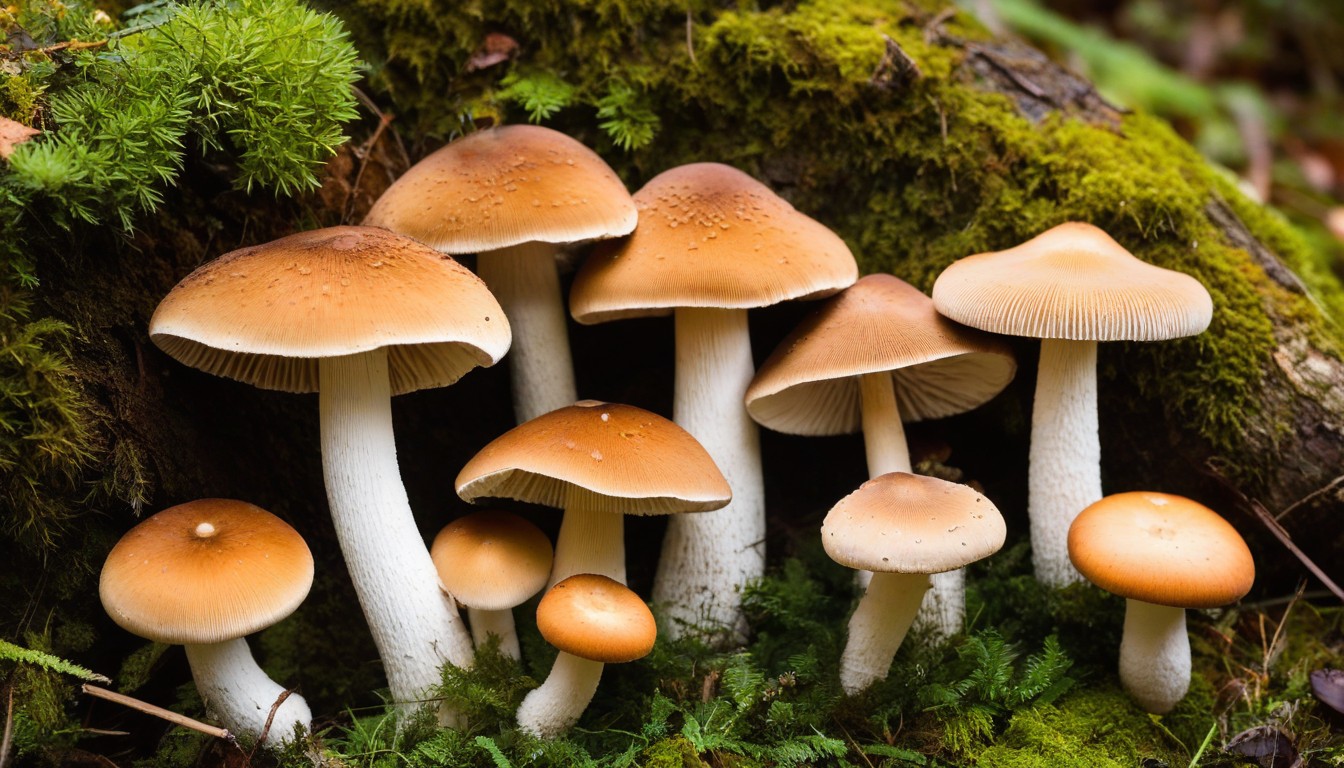
Foraging for edible mushrooms in Utah can be a thrilling and rewarding experience, but it also poses some potential hazards. Follow these safety tips to ensure a successful and safe foraging experience:
- Do your research: Before you head out, make sure to familiarize yourself with the different types of mushrooms that grow in Utah and which ones are safe to eat. Use a reliable field guide or mushroom identification app to assist you in the proper identification process.
- Stay on the trail: Avoid wandering off the designated paths and trails, as this increases the risk of encountering poisonous mushrooms or damaging the surrounding vegetation or wildlife.
- Use the proper tools: Always carry a sharp knife and a sturdy basket or bag to store your harvested mushrooms. Avoid using plastic bags, as they can cause the mushrooms to sweat and spoil quickly.
- Wear protective gear: Dress appropriately for the weather and terrain, and wear sturdy shoes or boots to protect your feet from slippery or sharp surfaces.
- Avoid certain mushrooms: Be aware of the toxic mushrooms that grow in Utah, such as the death cap or the destroying angel. These mushrooms can be deadly when ingested and should be avoided at all costs.
- Check with local authorities: Some public lands or parks may have restrictions or permits required for mushroom foraging. Check with local authorities before heading out to avoid any legal complications.
By following these safety tips, you can ensure a safe and enjoyable foraging experience in the beautiful Utah wilderness.
Foraging Equipment and Tools for Mushroom Hunting in Utah
Foraging for mushrooms in Utah can be a rewarding and exciting experience. However, it is essential to have the right equipment and tools to ensure a successful foraging adventure. Here are some foraging equipment and tools that every mushroom hunter should have:
Basket
A sturdy basket is essential for carrying your harvested mushrooms. A basket with an open weave design is ideal, allowing spores to fall and spread as you forage for more. Avoid plastic bags as they can trap moisture and lead to spoilage.
Knife
A sharp knife is a must-have tool for mushroom hunters. Use a knife with a curved blade to carefully cut the mushroom stem from the ground, leaving the root and surrounding area intact. Avoid tugging or pulling the mushroom out, as it can damage the mycelium and prevent future growth.
Field Guides
Field guides can help you identify the different mushroom species found in Utah. Look for guides specific to the region and season to ensure accuracy. Consider investing in a portable version that you can easily carry on your foraging trip.
Mushroom Identification Apps
In addition to field guides, mushroom identification apps can also be a handy tool for mushroom hunters. There are several apps available that provide detailed information and photos of different mushroom species. However, it’s essential to cross-check with other resources to ensure accuracy.
GPS Navigation
Exploring the great outdoors can be thrilling, but it can be easy to get lost without adequate navigational tools. Invest in a reliable GPS device or download navigation apps to help you navigate the wilderness and mark your favorite mushroom hunting spots.
Protective Gear
Protective gear, such as gloves and long sleeves, can help protect you from potential hazards, such as poisonous plants and insects, while mushroom hunting. Additionally, consider wearing comfortable and durable footwear suitable for the terrain.
By having the right equipment and tools, you can ensure a safe and unforgettable mushroom hunting experience in Utah.
Sustainable Foraging Practices in Utah
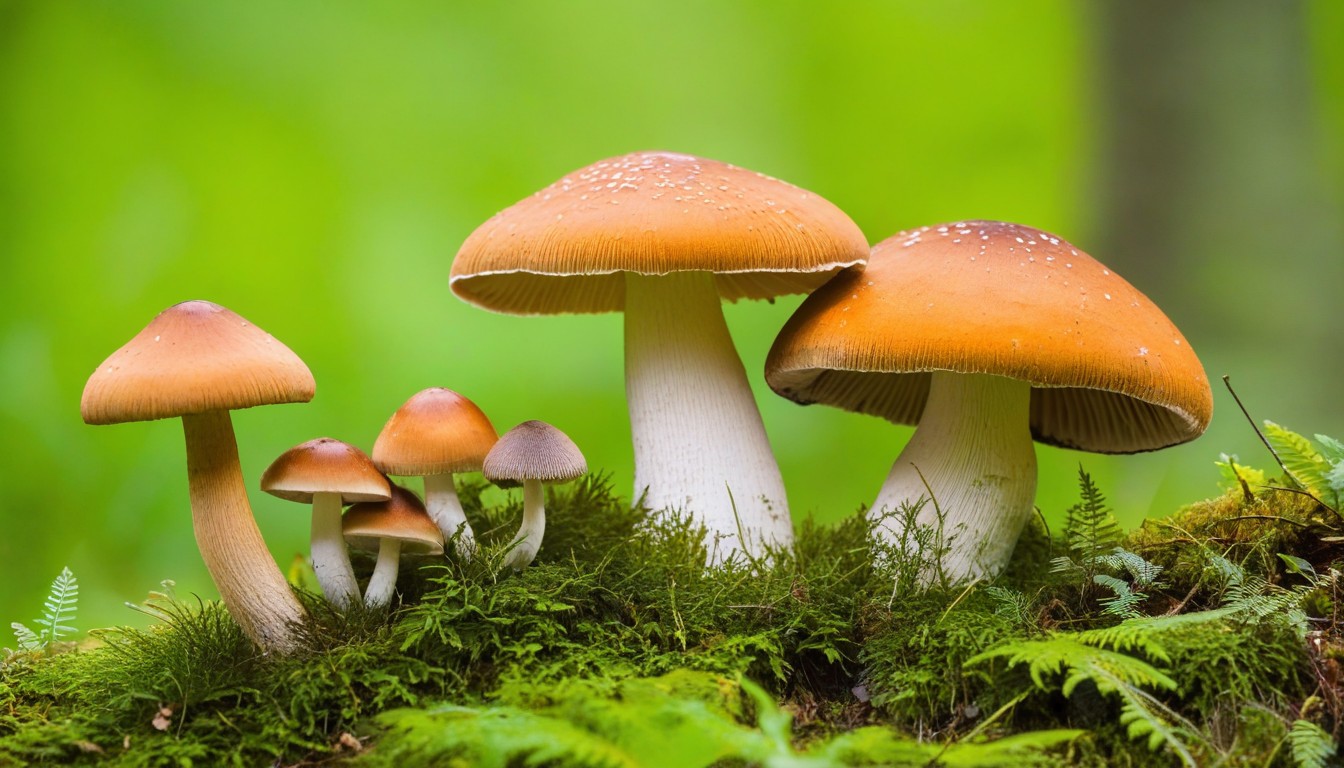
Foraging for edible mushrooms in Utah can be a rewarding and sustainable outdoor activity when done responsibly. By following sustainable foraging practices, we can help protect the natural habitats of the mushrooms, support the delicate ecosystem, and preserve the opportunity to forage for years to come.
Here are some ethical harvesting guidelines for sustainable foraging in Utah:
1. Know Your Mushroom Species
It’s crucial to correctly identify the mushrooms you are gathering and only select the edible ones to avoid harming the surrounding environment and ecosystem. Bring along a reliable guidebook or app to help with identification, and never pick mushrooms that you are not 100% sure of.
2. Harvest with Care
Avoid uprooting the mushrooms completely to allow their mycelium to grow back and continue their vital ecological role. Use a sharp knife or pair of scissors to cut the stem near the base, leaving the rest of the mushroom untouched. This will allow the mushroom spores to spread and reseed new growth in the same area.
3. Respect the Natural Habitat
Avoid harvesting in areas where the mushrooms are sparse or endangered. Stick to areas that have a plentiful supply, and focus on gathering only what you need. Leave enough mushrooms for others to enjoy and for the continued growth of the next season. Do not damage the ecosystem or leave behind any trash or debris.
4. Follow Local Regulations
Check the local regulations for the area where you plan to forage and follow any restrictions on harvesting quantities, residues, and equipment use. Respect private property boundaries and only forage on public land or with the permission of the landowner.
By practicing sustainable foraging, we can preserve the natural beauty of Utah and continue to enjoy the benefits of foraging for years to come.
Culinary Delights: Cooking with Utah’s Edible Mushrooms
Foraging for edible mushrooms in Utah is just the beginning of your culinary adventure. From soups and stews to sauces and side dishes, edible mushrooms add depth and umami to any recipe. In this section, we’ll explore different cooking techniques, recipe ideas, and flavor profiles of some of Utah’s most popular edible mushrooms.
Utah Chanterelle Mushroom
With its earthy, nutty flavor, the Utah Chanterelle mushroom is a perfect addition to pasta dishes, risottos, and sauces. Lightly sauté in olive oil or butter, season with salt and pepper, and toss with your favorite pasta for a simple yet delicious meal.
Morel Mushrooms
Morel mushrooms have an intense, earthy flavor and a rich meaty texture, making them perfect for stews and gravies. Sauté with onions and garlic, add a splash of red wine, and simmer until tender.
Pine Mushroom
Pine mushrooms have a strong, pine-like flavor that pairs well with umami flavors. They are ideal for stir-fries and soups. Slice them thinly and pan-fry or toss with your favorite vegetables and noodles.
Tip: When cooking with edible mushrooms, avoid washing them with water. Instead, brush off any dirt with a soft brush or cloth to preserve their delicate texture and flavor.
Incorporating edible mushrooms into your cooking repertoire is a delicious and healthy way to add unique flavors and textures to your dishes. Whether you prefer simple preparations or complex recipes, Utah’s edible mushrooms offer culinary delights for any taste.
Mushroom Preservation and Storage Tips
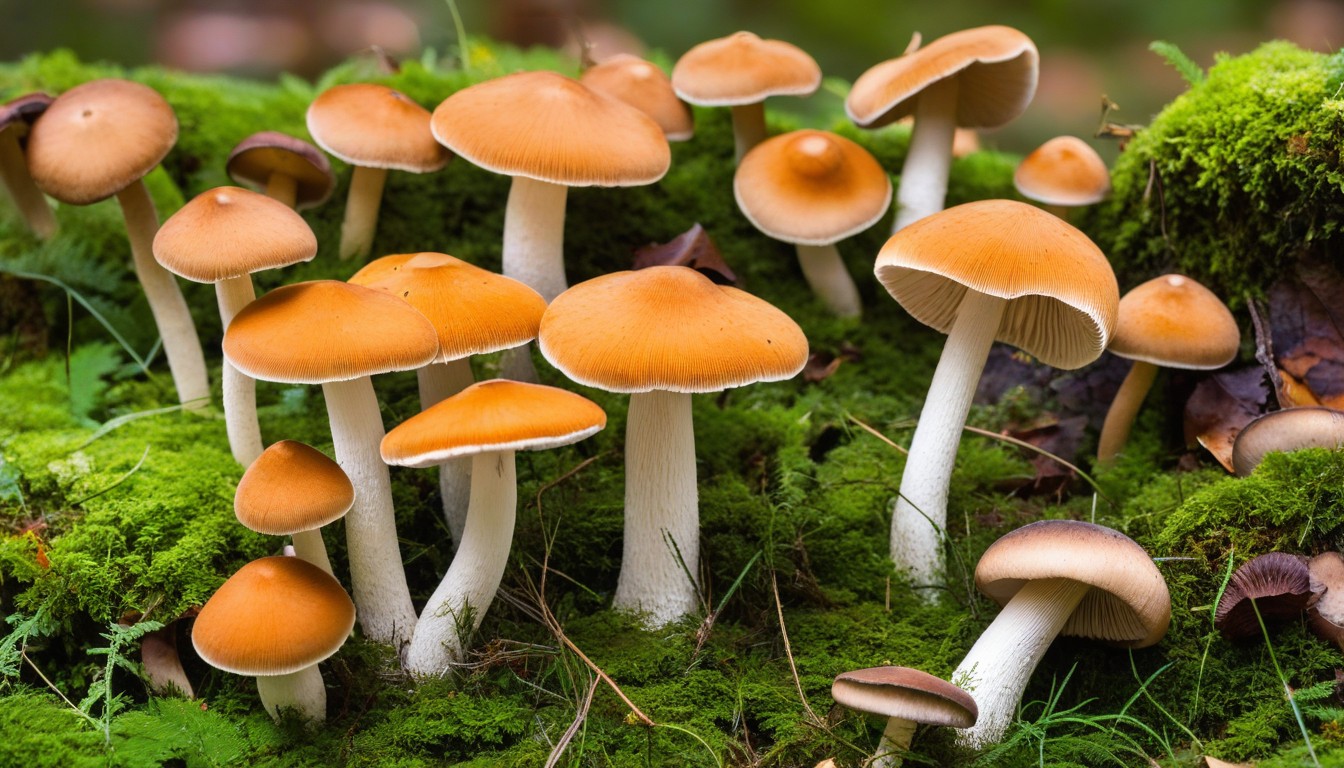
After a successful mushroom foraging trip in Utah, it’s important to properly preserve and store the harvested mushrooms to extend their shelf life. Here are some valuable tips to keep in mind:
|
Preservation Method |
Instructions |
|---|---|
|
Drying |
– Preheat your oven to 150-200 degrees Fahrenheit. – Spread out mushroom slices on a baking sheet, making sure they are not touching. – Place the sheet in the oven, prop the door open with a wooden spoon, and let the mushrooms dry for 2-3 hours. – Store the dried mushrooms in an airtight container once they become crisp. |
|
Freezing |
– Clean and chop the mushrooms. – Blanch the mushrooms in boiling water for 90 seconds. – Rinse the mushrooms in cold water and let them dry. – Place the mushrooms in freezer bags and remove as much air as possible. – Seal the bags and freeze. |
|
Storing in the Fridge |
– Store fresh mushrooms in a paper bag to keep them dry. – Place the bag in the fridge and use the mushrooms within 3-5 days. – Do not clean or wash the mushrooms until ready to use. – Avoid storing near vegetables with high moisture levels, as they can cause the mushrooms to spoil. |
By following these tips, you can make sure your foraged mushrooms stay fresh and delicious for longer, allowing you to savor the flavors of Utah’s edible mushrooms for an extended period.
Additional Resources for Mushroom Foragers in Utah
For those looking to enhance their knowledge and experience in mushroom foraging in Utah, there are several resources available:
|
Resources |
Description |
|---|---|
|
Utah State University Extension |
Offers workshops, classes, and educational materials on mushroom identification, mushroom cultivation, and foraging preservation. |
|
Utah Mycological Society |
A local group of mushroom enthusiasts who hold regular meetings, forays, and educational events. Joining this group is a great way to connect with other mushroom hunters and learn more about local mushroom species. |
|
The Complete Mushroom Hunter: An Illustrated Guide to Finding, Harvesting, and Enjoying Wild Mushrooms |
A comprehensive guidebook written by Gary Lincoff that covers everything from mushroom identification to cooking and preserving techniques. |
|
All That the Rain Promises and More: A Hip Pocket Guide to Western Mushrooms |
Written by David Arora, this pocket guide features detailed descriptions and illustrations of over 200 mushroom species found in the western United States, including Utah. |
These resources are just a few examples of the many available to mushroom foragers in Utah. By utilizing these tools and connecting with like-minded individuals, you can enhance your foraging skills and make the most out of your mushroom hunting expeditions.
Conclusion
Exploring the edible mushrooms of Utah through foraging can be a truly unique and rewarding experience. With the help of this gourmet foraging guide, you now have the knowledge and tools to identify, gather, and cook delicious dishes with various mushroom species found in the region.
Remember to always prioritize safety by following proper identification techniques and avoiding poisonous mushrooms. Additionally, using sustainable foraging practices will help preserve the local ecosystem and contribute to the longevity of mushroom habitats.
We hope this guide has inspired you to venture into the exciting world of mushroom foraging in Utah. Happy foraging!
FAQ
What are edible mushrooms?
Edible mushrooms refer to fungi that are safe and suitable for consumption. These mushrooms possess characteristics that distinguish them from poisonous or inedible varieties. They can be delicious additions to various culinary dishes and offer unique flavors and textures.
How can I identify edible mushrooms in Utah?
Identifying edible mushrooms requires knowledge and experience. It is crucial to learn about the distinguishing features of different mushroom species, such as cap shape, color, gills, and the presence of a veil or ring. Utilizing field guides, joining local foraging groups, and taking mushroom identification workshops can help enhance your identification skills.
Are there any poisonous mushrooms in Utah that I should be aware of?
Yes, there are several poisonous mushrooms in Utah. It is vital to exercise caution and avoid consuming any mushroom unless you are certain it is safe. Poisonous mushrooms can cause severe illness or even be fatal. If you are unsure about a mushroom’s edibility, it is best to consult with an expert or err on the side of caution and refrain from consuming it.
Where can I legally forage for mushrooms in Utah?
It is essential to research and understand the regulations and restrictions concerning foraging in Utah. While foraging is generally permitted on public lands, including national forests and designated foraging areas, it is important to respect private property rights and obtain the necessary permits or permissions when required.
Can I sell the mushrooms I forage in Utah?
Selling foraged mushrooms in Utah is subject to specific regulations and permits. It is recommended to consult with local authorities or agricultural agencies to ensure compliance with the laws regarding the sale of wild mushrooms. Engaging in illegal commercial foraging can lead to fines or legal consequences.
What time of year is best for mushroom foraging in Utah?
The timing for mushroom foraging in Utah depends on the species and seasonal conditions. Different mushroom species thrive during specific times of the year, primarily in the spring, summer, and fall seasons. It is advisable to research the seasonal patterns and consult local foraging resources to determine the optimal time for mushroom hunting.
Can I forage for mushrooms in national parks in Utah?
Mushroom foraging regulations in national parks vary, and in some cases, foraging may be prohibited to protect the natural environment. It is recommended to check the specific rules and regulations of the national park you plan to visit and obtain any necessary permits or permissions before engaging in foraging activities.
What tools do I need for mushroom foraging in Utah?
As a mushroom forager, it is essential to have a few basic tools. These may include a mushroom knife with a brush for cleaning, a basket or mesh bag for collecting mushrooms, and a field guide or smartphone app for mushroom identification. Additionally, it is crucial to dress appropriately for outdoor exploration, including wearing sturdy shoes and carrying water and snacks.
Can I take my dog with me when mushroom foraging in Utah?
The permissibility of bringing a dog for mushroom foraging in Utah depends on the specific location and any rules or regulations in place. Some areas may allow dogs but require them to be on a leash, while other regions may prohibit pets to protect wildlife and natural habitats. It is best to check the local regulations and guidelines before bringing a dog along for foraging.
What are the best ways to preserve foraged mushrooms in Utah?
There are several effective methods for preserving foraged mushrooms in Utah. Drying mushrooms is a popular technique, and they can be air-dried, dehydrated, or even preserved in a low-temperature oven. Freezing mushrooms is another option, allowing you to enjoy their flavors and textures later. It is important to follow proper preservation techniques to ensure the mushrooms retain their quality.
Are there any local resources or workshops in Utah to learn more about mushroom foraging?
Yes, Utah offers various resources and workshops for individuals interested in mushroom foraging. Local mycological societies, foraging clubs, and nature centers often host educational programs, workshops, and guided forays. Additionally, online resources, such as websites and forums, can provide valuable information and connect you with experienced foragers in the area.

